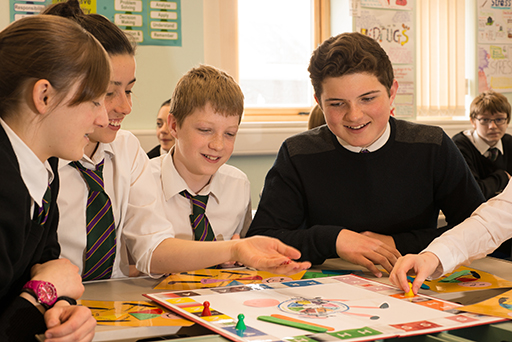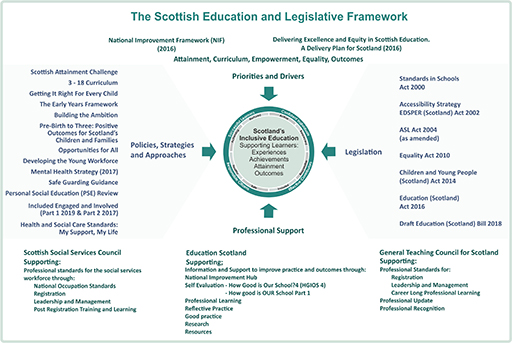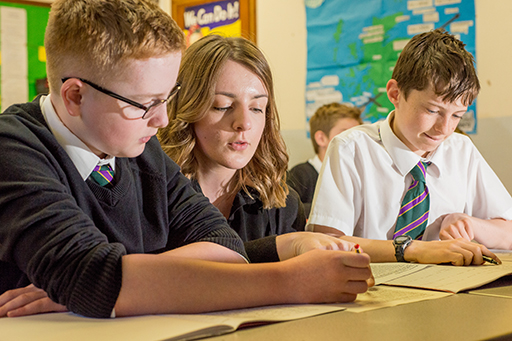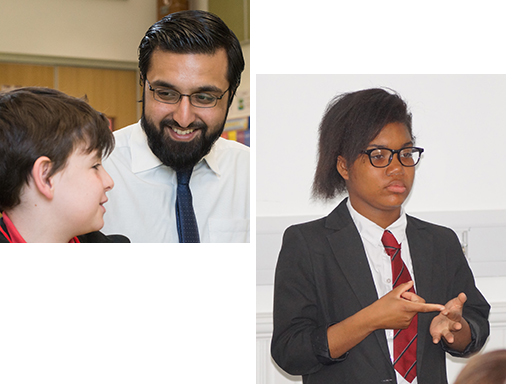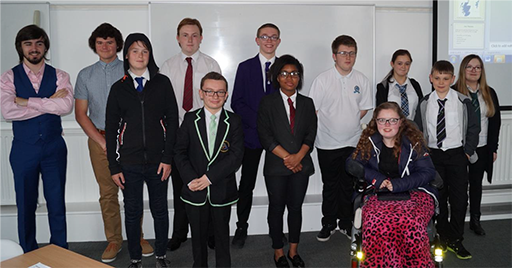Use 'Print preview' to check the number of pages and printer settings.
Print functionality varies between browsers.
Printable page generated Sunday, 23 November 2025, 5:06 AM
1 Module introduction
Section overview
In this section you will explore the following areas:
1.1 Overview of the CIRCLE Framework of Inclusion
1.2 Scottish context for inclusion, equality and equity
1.3 Inclusion in Practice: The CIRCLE Framework
1.4 Learner’s thoughts, views and ideas.
1.1 Overview of the CIRCLE Framework of Inclusion
The CIRCLE Framework of Inclusion was developed by Edinburgh City Council, Queen Margaret University and NHS Lothian to promote effective inclusive practice in classrooms. A version for primary schools was first developed followed by a secondary version.
Many learners within secondary schools have identified emerging additional support needs that may impact on their ability to engage with the curriculum and/or to participate fully in school life. This resource will help secondary school staff support these learners.
The Secondary CIRCLE Framework of Inclusion was developed primarily for subject teachers but will also be relevant for any secondary school staff who support learners with additional support needs. It provides an overview of the processes for providing that support and a reflective framework for considering additional support needs.
How was the information gathered which supported the creation of the CIRCLE Framework?
The Secondary CIRCLE Framework – The ‘CIRCLE Collaboration’ is a resource which represents the analysis of 164 contacts, including in-depth interviews and focus groups held in 5 mainstream secondary schools, 2 special schools and with other staff groups within the City of Edinburgh.
Further information on the how The CIRCLE Collaboration © was developed is available for you to read in ‘The CIRCLE Collaboration background’.
Activity 2: Introduction to the CIRCLE Framework
Watch this film ‘What is the CIRCLE framework (secondary)?’ in which a member of the CIRCLE team explains the background and rationale for the CIRCLE Framework of Inclusion (film duration 2:56 minutes). A transcript of this film is available.
The CIRCLE Framework introduces the importance of considering inclusion in terms of four main areas:
Skills
Motivation
Structures and routines
The environment (physical and social).
The interactive jigsaw diagram in Figure 2 below represents how these factors are interlinked to support inclusion. Hover over each segment of the jigsaw - number 1 displays a definition and number 2 displays an example.
Activity 3: CIRCLE Framework impact
Watch these two films in which a deputy head teacher discusses the benefits of the CIRCLE framework and a Support for Learning teacher explains why the CIRCLE framework has been useful in her role.
Film of a deputy head teacher discussing the CIRCLE Framework. (film duration 3:32 minutes)
Film of a Support for Learning teacher discussing the CIRCLE Framework (film duration 2:06 minutes)
Questions on these films will be included in the end of module quiz.
1.2 Scottish context for inclusion, equality and equity
This section uses materials covered in the Education Scotland module ‘Introduction to Inclusive Education’. If you have accessed that module, please note it is important that you still complete this section in order to complete all the requirements of achieving the badge for this module.
Scottish education is based on the belief that education is a human right and that all children and young people should be supported to reach their fullest potential. Scotland’s education system is designed to be an inclusive one for all children and young people in Scottish schools, with or without additional support needs. This inclusive approach not only allows children and young people to thrive in their community but also contributes to all children and young people’s understanding and appreciation of diversity and helps to build a more just society.
Scotland’s ‘needs led’ system places the learner at the centre and the provision of support is not dependent upon a formal label or identification of need such as dyslexia, autism or a physical disability. Figure 4 provides an overview of the national legislation and policy which underpins the Scottish educational context of inclusion and equality. It is not intended as an exhaustive list of all Scottish policy which refers to inclusion but gives a broad overview of some of the key policy documents.
Legislative and policy framework
Scotland has a wide range of legislation to support inclusion and equality in education.
Read the ‘Legislative and Policy Framework summary’ which provides you with an overview of the most recent legislation and policies that are listed below:
Disability Strategies and Pupils’ Educational Records (2002)
Curriculum for Excellence
Additional Support for Learning (Scotland) Act 2004 (as amended 2009) (ASL ACT)
Supporting Children’s Learning Code of Practice (Revised 2017) to support the ASL ACT (Code of Practice to support the ASL ACT)
The Getting it right for every child approach
Equality Act (2010)
Children and Young People (Scotland) Act (2014)
Education (Scotland) (2016).
These promote a child centred approach to encourage every child to reach their ‘fullest potential’. Our legislation ensures rights and entitlements for children and young people to education, support and wellbeing. There is a range of legislation and educational policies that places duties and expectations on schools and local authorities to ensure that they:
deliver an inclusive education
support learners to achieve to the best of their ability
do not discriminate against those with protected characteristics
provide assessments when requested.
Children’s rights and entitlements are fundamental to Scotland’s approach to inclusive education. It is supported by the legislative framework and key policy drivers including, Curriculum for Excellence, the Getting it right for every child approach and the Framework for Professional Standards for teachers. These are underpinned by a set of values aligned to social justice and commitment to inclusive education.
Activity 4: Legislation and policy
Match the legislation with the correct summary by dragging it into the appropriate box in the table.
Two lists follow, match one item from the first with one item from the second. Each item can only be matched once. There are 7 items in each list.
Disability Strategies and Pupils’ Educational Records (2002)
Additional Support for Learning (Scotland) Act 2004 (as amended 2009);
Code of Practice to support the ASL ACT
The Getting it right for every child approach
Equality Act (2010)
Children and Young People (Scotland) Act (2014)
Education (Scotland) (2016)
Match each of the previous list items with an item from the following list:
a.Introduces measures to improve Scottish education and reduce pupil’s inequality of outcomes.
b.Its purpose is to ensure an inter-agency approach across education, health and social work to improve outcomes for children and young people.
c.Places a duty on schools and education authorities to eliminate unlawful discrimination, harassment and victimisation of learners with protected characteristics and to actively promote equality of opportunity.
d.Provides the legal framework for identifying and addressing the additional support needs of children and young people who face a barrier, or barriers, to learning
e.Requires (responsible bodies) to develop and publish an accessibility strategy.
f.Places a duty on local authorities and schools to ensure the wellbeing of children and young people is safeguarded, supported and promoted.
g.Designed to help schools, parents and others to understand the ASL Act and ensure its implementation.
- 1 = e,
- 2 = d,
- 3 = g,
- 4 = b,
- 5 = c,
- 6 = f,
- 7 = a
Inclusion and equality
What is meant by the term ‘inclusion’? A range of definitions have been developed and these contribute to an understanding of inclusive education.
The Scottish Government vision for inclusive education states that:
'Inclusive education in Scotland starts from the belief that education is a human right and the foundation for a more just society. An inclusive approach which recognises diversity and holds the ambition that all children and young people are enabled to achieve to their fullest potential is the cornerstone to achieve equity and excellence in education for all of our children and young people’.
The UNESCO (2008) definition states that inclusive education is:
‘An ongoing process aimed at offering quality education for all while respecting diversity and the different needs and abilities, characteristics and learning expectations of the students and communities, eliminating all forms of discrimination’.
How Good is Our School? (4th Edition) states that:
‘Inclusion means taking positive action and intervening in order to enable achievement for all by building and fulfilling the potential of every child, young person and adult’.
Equality
Equality is described as the removal of discrimination, disadvantage, inequality and/or barriers which can affect people on the grounds of the protected characteristics set out in the Equality Act (2010):
Age
Disability
Sex
Gender reassignment
Pregnancy and maternity
Race
Religion or belief
Sexual orientation.
The public sector equality duty also covers marriage and civil partnerships, with regard to eliminating unlawful discrimination in employment. Therefore, schools and education authorities do not have a responsibility as learners are not employees.
The Equality Act (2010) also gives the duty to advance equality of opportunity between people who share a protected characteristic and those who do not and to foster good relations between them.
Equity
What does equity mean? Equity means that people are treated fairly, but are not necessarily treated the same.
‘Equity in education means that personal or social circumstances such as gender, ethnic origin or family background are not obstacles to achieving educational potential and that all our young people are well supported to secure wellbeing, skills for learning, life and work and the best possible post-school destination’.
Education Scotland, How Good is our School? 4th Edition, p. 59
Equity is generally understood to refer to fairness and impartiality for people and sometimes especially relating to fairness for people facing socio-economic disadvantage.
1.3 Inclusion in Practice: The CIRCLE Framework
CIRCLE begins from the stand point that teachers are experts in teaching and that what is required to support inclusion is a framework that allows this expertise to be applied in the most effective way, using a set of general principles.
Within the CIRCLE Framework, inclusion is referred to as the extent to which a learner participates in school life, is accepted by their peers and progresses with their learning.
There can be a tendency to focus on how specific physical, sensory or behavioural strengths and support needs can impact on a learner’s ability to be included in school; however, this is usually only a small part of the picture. We know from current research, for example Maciver et al. (2018), that inclusion is influenced by a combination of factors including the physical environment, attitudes, expectations and opportunities, in addition to the learner’s skills and abilities.
Many resources focus on skill development. The CIRCLE Framework, however, introduces the importance of considering inclusion in terms of four factors:
The environment (physical and social)
Structures and routines
Motivation
Skills.
The terminology for these four factors comes from the Model of Human Occupation (MOHO), Kielhofner (2008). Further reading is available in the Useful information section.
The interactive jigsaw diagram in Figure 6 below represents how these factors are interlinked to support inclusion. Hover over each segment of the jigsaw - number 1 displays a definition and number 2 displays an example. Each of the factors within the CIRCLE Framework are described fully in Section 3 with examples to illustrate the concepts.
1.4 Learners’ thoughts, views and ideas
As part of the research process which formed the basis of the CIRCLE resource, a number of learners in secondary schools who required additional support were consulted. These views were used to help inform the structure and content of this resource.
Listening to the voices of learners provides valuable insight; their perspectives are vital to help us to better understand the nature of their strengths and support needs, their feelings about these and what can be done to support them.
To explore the views of these young people, download ‘Learners' views on inclusion’ which is a summary of what they told the CIRCLE Team.
Young Ambassadors for Inclusion
Young people who require additional support have a wealth of information, ideas and priorities to share. It is therefore vital that we work in partnership. This is illustrated by the work of the Young Ambassadors for Inclusion, a group of young people who require additional support, who are nominated by their local authorities to work to improve inclusion in schools. The materials on the Young Ambassadors can be found on the National Improvement Hub page. This page provides ideas on ways that you might consult with groups of young people in your own setting.
As well as consulting with groups of young people, it is also vital to work in partnership with them to identify their individual needs, the support they require and to review whether these needs have been met.
Activity 5: Young Ambassadors for Inclusion
Watch ‘Ask us, hear us, include us (Education Scotland, 2018) to hear the views of the Young Ambassadors for Inclusion in a short film which they created for teachers.
Reflective Task: Learners’ thoughts, views and ideas
In your Reflective Log consider your own practice (with reference to the Learners’ views on inclusion summary you previously downloaded) in the following areas:
learners’ feelings
learners’ strengths and support needs
what works well from the learners’ perspectives
qualities of an ideal teacher
how to coordinate support keeping the learner at the centre.
Having watched the short film film ‘Ask Us, Hear Us, Include Us’, consider the following questions and make some notes in your Reflective Log:
a.How does the young people’s feedback relate to your own experience of supporting learners with additional support needs?
b.How do some of the summaries and quotes from the download and the film make you feel?
c.Outline one strategy you are going to try as a result of this reflection on the perspectives of the learners.
